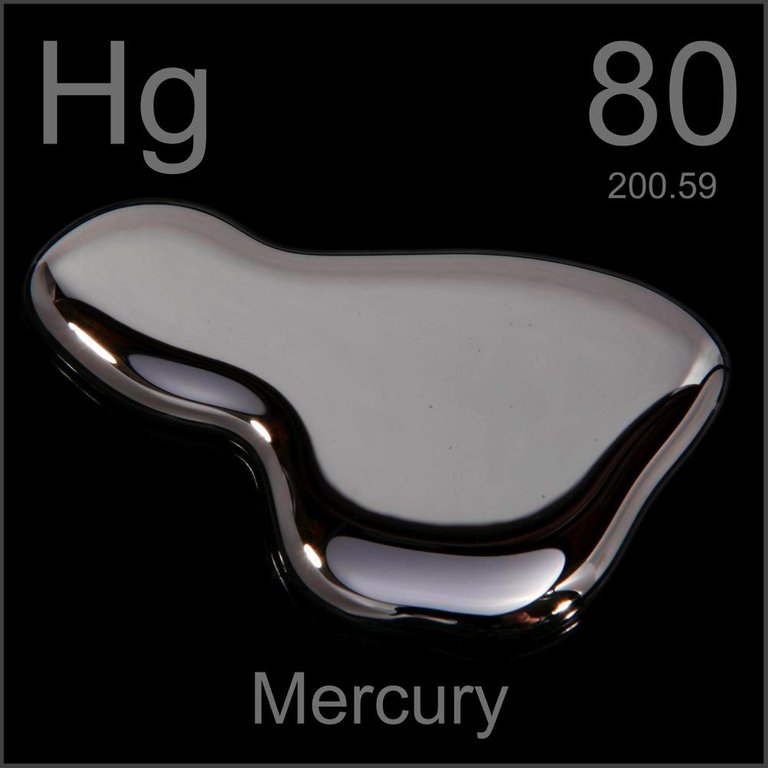Inorganic Metallic Poisoning - Mercury and Zinc Poisoning
Still on Inorganic Metallic Poisoning, today we will be looking at Mercury poisoning and Zinc poisoning.
Mercury also known as quicksilver is a bright silver-luster liquid metal that exists in both a metallic form and sulfide form. Mercury is not poisonous in its metallic form since it is not absorbed but it is poisonous in its vaporized form which is either inhaled or has contact with the skin. Mercury combines with the sulfhydryl groups in enzymes to become toxic. Mercury can be gotten from Mercuric chloride (which is a white crystalline powder), Mercurous Chloride/subchloride (Amorphous), Mercuric Oxide, Mercuric cyanide, Mercury Nitrate, and organic mercury compound (found in fungicides). Mercuric Chloride is the main poison that causes acute poisoning.

Acute Mercury poisoning can be associated with the Mouth and Gastrointestinal Tract, and it can also be systemic. Symptoms of mercury poisoning in the mouth are a metallic taste which is immediate, after the metallic taste are burning sensation down to the stomach, corrosion of the tongue, purging, and painful tenesmus, swollen and inflamed gums, and increased salivation. Systemic symptoms include; sunken eyes, clammy skin, pale skin, dilated pupils, increased pulse rate, convulsions, fainting, and renal failure, and it can lead to death. Mercury fetal dose is around 1 gram to 2 grams, with a fatal period being a few hours. Treatment for mercury poisoning patients includes using sodium formaldehyde sulphoxylates (Na⁺HOCH₂SO₂⁻) to wash the stomach, using Egg albumin is a good idea after which gastric lavage is used to flush the albuminate of mercury. Magnesium sulfate and charcoal are used to absorb the poison, Dimercaprol, also called British anti-Lewisite and penicillamine are antidotes. Patients with renal complications can be treated using dialysis. Post-mortem findings will show a grayish-white escharotic appearance in the mouth, inflamed GIT, corroded mucus membrane, kidney nephritis, and liver and heart fatty degeneration.
Mercury poisoning can also be chronic, and this happens as a result of an acute attack after effect on a patient, continuous absorption as a result of constant exposure to mercury poisoning. Symptoms include a metallic taste, loosening of teeth, intense salivation, inflamed gum, blue-black teeth line, abortion, skin irritation, and nephritis. Treatment will be taking the patient away from the source where they are in contact with the mercury, and symptomatic treatment for symptomatic cases. Post-mortem findings include nephritis and mercury re-excretion in the large intestine.

Zinc poisoning is another metallic inorganic poison that I will be discussing. It is a bluish-white metal that is lustrous. It is of three types of salts and they are all poisonous in their own way. These salts are Zinc Sulphate which is also known as white vitriol acting as an irritant poisoning that could cause gastroenteritis, and show symptoms such as a metallic taste in the mouth, Gastrointestinal irritation, burning in the abdomen, collapse, worst-case scenario death. Its lethal dosage is about 15 grams which will lead to fatality in 5 days or about 90 grams which will cause death in hours (about 2 or more hours). Similar to all irritant poisoning, Zinc poisoning requires washing of the stomach, and the treatment should be symptomatic since there is no specific antidote.
Zinc Chloride is another corrosive salt of Zinc that is poisonous. It causes damage to the mouth, the gastrointestinal tract, and the stomach causing vomiting, and shock and it will show symptoms of Lead poisoning as well during chronic poisoning. There will be cases of Remissions and reoccurrence of symptoms. 400mg is its fatal dose, having a few hours before the poisoned person dies. Treatment will be similar to other treatments and post-mortem findings will be similar to that of corrosive poisoning since it is a corrosive poison.
Zinc Phosphide is the third type of zinc salt which is a dark grey, crystalline powdered form which reacts with the gastric acid to produce Phosphine gases after which it mixes with the blood, thereby travelling to the liver and the lungs. The symptoms of Zinc Phosphide are Pulmonary Edema, dyspnea, circulatory collapse, bradycardia, shock, acidosis, convulsion, and death. Its lethal dose is about 5 grams of Zinc phosphide with a fetal period is about 24 hours. Treatment will include stomach wash when Ingested with sodium bicarbonate, while in local areas it should be washed with soap and water. It still sticks to the gastric mucosa even after washing so the patient should be closely watched. Other treatments will be giving the patient Vitamin K, sedatives, and corticosteroids. Post-mortem findings will be hemorrhage of the skin, the smell of garlic in the stomach, and congestion of the liver, kidney, and spleen.
https://www.ncbi.nlm.nih.gov/books/NBK499935/
https://www.who.int/news-room/fact-sheets/detail/mercury-and-health
https://emedicine.medscape.com/article/1175560-overview
https://www.epa.gov/mercury/health-effects-exposures-mercury
https://pubchem.ncbi.nlm.nih.gov/compound/Zinc-sulfate#section=2D-Structure
https://www.mountsinai.org/health-library/poison/zinc-poisoning
https://www.ncbi.nlm.nih.gov/books/NBK554548/
https://www.ncbi.nlm.nih.gov/pmc/articles/PMC4101206/
Thanks for your contribution to the STEMsocial community. Feel free to join us on discord to get to know the rest of us!
Please consider delegating to the @stemsocial account (85% of the curation rewards are returned).
Thanks for including @stemsocial as a beneficiary, which gives you stronger support.